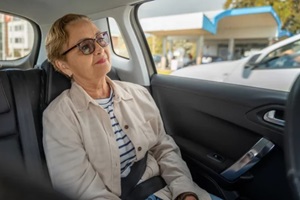 As people age, it is common for their abilities to shift due to mental and physical changes that are a normal part of aging. This area can be wrought with emotion for families, as older adults rarely want to give up their driving privileges.
As people age, it is common for their abilities to shift due to mental and physical changes that are a normal part of aging. This area can be wrought with emotion for families, as older adults rarely want to give up their driving privileges.
However, senior citizen transportation can replace regular driving, providing a safer way for your elderly loved one to get where they want or need to go.
Here is a guide for family members looking into senior transportation planning for their older loved ones.
Assessing Senior Transportation Needs
Whether or not someone can still drive comes down to their physical and cognitive abilities. Factors to consider when assessing your loved one’s driving safety and whether to transition to transportation services include:
- Ability to stay in one lane
- Difficulties looking to the side during merging or reversing
- Confusion regarding traffic signs, lights, and indicators
- Getting lost easily
- Delayed reaction times
- Risky driving behavior
Some older individuals may acknowledge that their skills are not what they used to be, while others either cannot or choose not to see the current state of their driving abilities.
Open communication and ongoing collaboration are essential, regardless of how previous conversations have gone. Avoid being accusatory; instead, discuss different driving options to preserve your loved one’s safety and the safety of others on the road.
They do not need to stop leaving the house, and senior transportation services can be even more convenient than driving.
Exploring Senior Transportation Options
Multiple types of senior transportation options are available, each with advantages and disadvantages that depend on your family member’s goals and abilities. The most common choices are:
Public Transit
For seniors still able to navigate confidently, public transit can be a simple and accessible option. Buses and subways run according to a predictable schedule, so your loved one can plan their excursions reliably.
These services also typically offer accessible options for those with mobility devices such as canes and wheelchairs, so limited mobility may not stop an older person from accessing public transportation. However, the transport service is not geared specifically toward your loved one, which means they have no incentive or ability to watch over them once they leave the vehicle.
Rideshares
For seniors with more rigid timelines or who do not want to use public transit, ridesharing can solve their transportation problems. By scheduling a ride at a convenient time, they do not have to wait on transit schedules. However, rideshares are more expensive, and few are equipped with the capacity to handle wheelchairs and other devices.
Specialized Senior Transport
Many local communities provide specialized transportation options for neighborhood seniors for free or at low cost. These services typically use vans equipped with wheelchair lifts and other enhanced safety features, and the drivers often wait outside the senior’s destination to ensure they make it inside.
They may also continue to wait until the older person returns to ensure they do not get lost and make it back home safely. However, the quality of these services may vary, as they are less closely regulated, and they may not be available on a senior’s specific schedule the way rideshares are.
Volunteer Drivers
Some local organizations may offer volunteer services to drive older folks to important appointments and meetings. This is especially common with churches, but other entities may participate as well. Volunteer drivers are the most affordable option (though they appreciate tips), but as with rideshares, they may be driving unmodified vehicles that do not offer wheelchair lifts or other accessibility features.
Additionally, because they are volunteers rather than professionals, they may not have medical training sufficient to deal with an emergency should one occur. The availability of a volunteer driver depends on their preferences, so scheduling may change repeatedly over time.
Addressing Safety and Accessibility
 No matter which option you select for senior transportation, be sure to consider the safety and accessibility of the vehicle. Useful items to look for include wheelchair lifts, ramps, seat belt reachers, modified seat belts, swivel cushions, and extra bars or rails.
No matter which option you select for senior transportation, be sure to consider the safety and accessibility of the vehicle. Useful items to look for include wheelchair lifts, ramps, seat belt reachers, modified seat belts, swivel cushions, and extra bars or rails.
Vehicles transporting wheelchairs should have the proper straps and locks to secure the chair during movement.
Find Senior Transportation in Your Area
Giving up driving can be an emotional time in your older loved one’s life, but it does not have to spell the beginning of being housebound. The experts at the Shepherd’s Center of Northern Virginia can help your family connect with local senior transportation in your community to keep your loved one mobile and engaged with the world.
Contact SCNOVA to learn more about the transportation options available to you.

